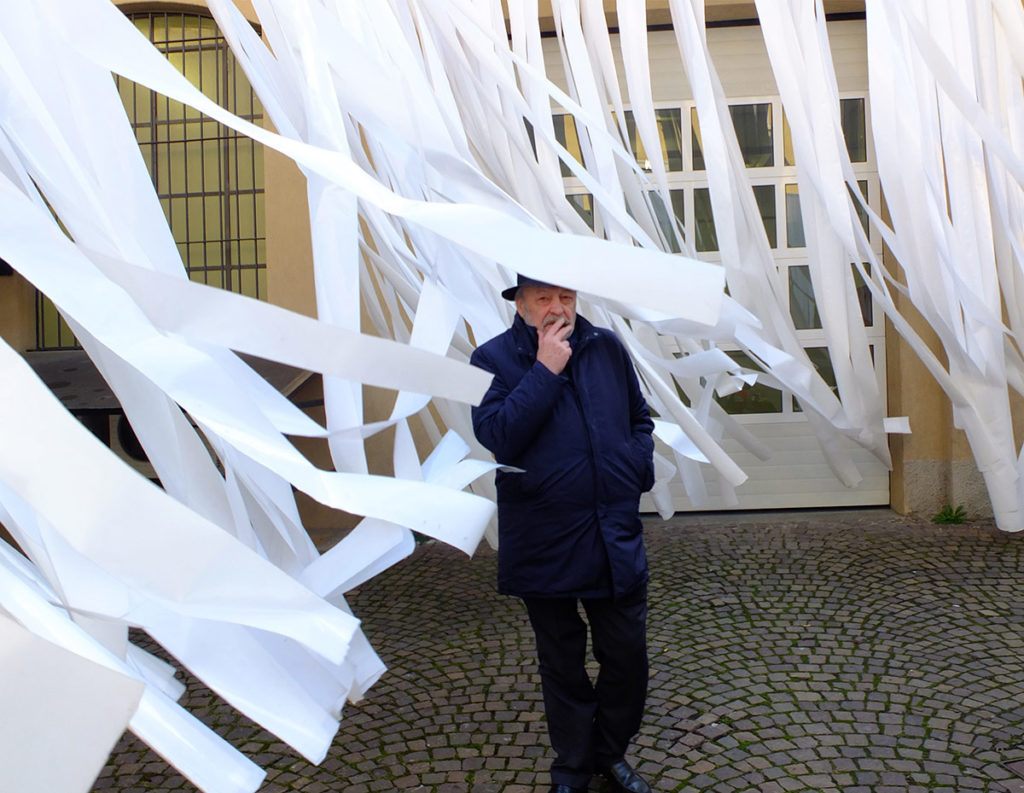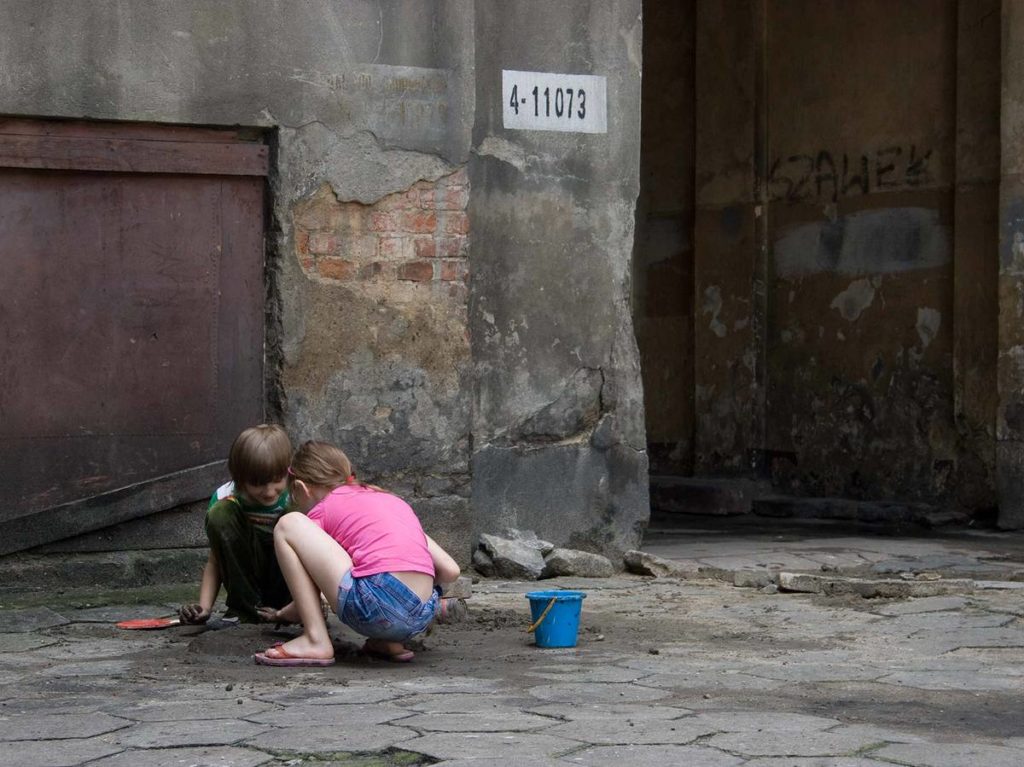Between activism, art and poetry, the augmented and liberating architecture of Gianni Pettena
Interview by Guillaume Désanges
With his roots in the Florentine scene, Gianni Pettena is a leading member of the Radical Architecture movement founded in Italy in 1965 to rethink the foundational principles of architecture. The movement sought to challenge the “imperative to build”, and to replace it with conceptual, artistic alternatives : free-thinking, imaginative new ways to live in the world. For Gianni Pettena, especially, this re-visioning of the principles of his discipline was expressed as a quest for the “primal roots” of architecture, based on open and mindful observation of nature, both wild and tamed. At the beginning of the 1970s, his journeys through the deserts of the American south-west defined the bedrock of a personal output that was both concrete and reflective, material and ideal. This awareness of the “natural” architectural potential of ecosystems untouched by Western industrialised culture, gave rise to numerous solo and group projects, installations, actions, performances and designs, together with sculptures, films and texts, both theory-based and intuitive, some of which were realised, others not : the key elements of his uncategorisable, highly original work. Pettena’s is an “expanded” or augmented” architectural practice, liberated and liberating, as it plies the open waters between activism, art and poetry.
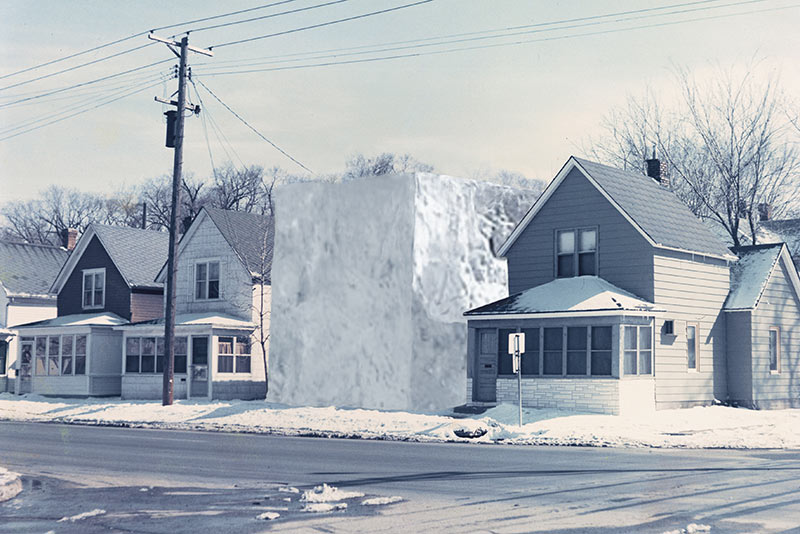
Gianni Pettena, Ice House I, 1971, installation, Minneapolis (United States), courtesy of the artist and Salle Principale, Paris © Studio Gianni Pettena
Guillaume Désanges (GD): I never know how to introduce you, you are often considered as an artist but I have chosen to call you an architect, because it is when grasped in the architectural ground that I find your work most interesting. How would you introduce yourself?
Gianni Pettena (GP): Somebody that had an architectural education, so who has the license to destroy the landscape but avoided to practice architecture the way it was suggested to him. Basically, I am someone that is in love with architecture and that continues to love it even after more than 50 years. And if you love, you love without restrictions. My practice is not a professional practice because it does not obey to restrictions of any kind, be they cultural, philosophical or political.
GD: Your piece called Paesaggi della memoria (1987), refers to your vision of the crest of mountains when you were a child, seminal for your ideas on architecture. Can you tell us more about this very first interest for the relationship between nature and architecture?
GP: Well, I remember the architecture of a square, in Bolzano, designed by Marcello Piacentini in the 30’s, which evoked for me some De Chirico’s paintings. It was really in dialogue with nature, the sky, and the Dolomites around. At that time, I was not thinking about architecture, but I was spontaneously thinking of this background surrounding me. I began to really think about architecture later, when I had to choose a study subject for university. Somehow, even unconsciously, architecture was a choice for not choosing, keeping open the doors for many practical professions. It was a field that was supposed to be open to your personal expression.
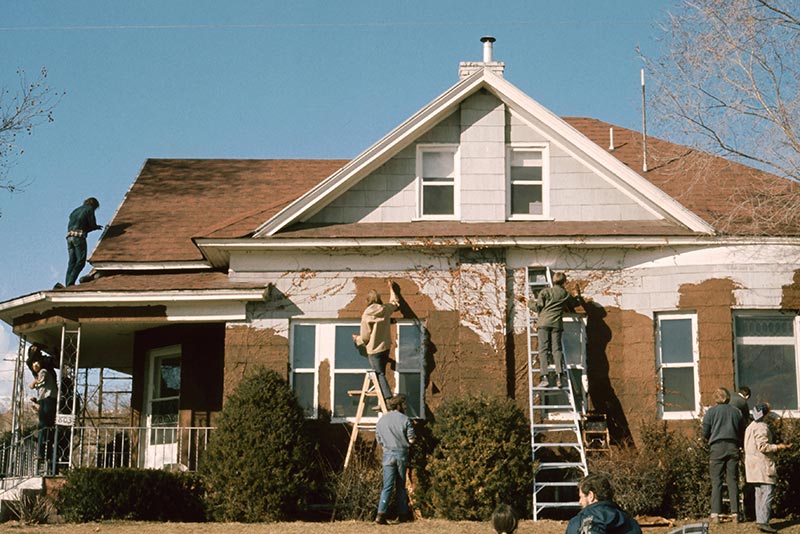
Gianni Pettena, Clay House, 1972, installation, Salt Lake City (Utah, United States), courtesy of the artist and Salle Principale, Paris © Studio Gianni Pettena
GD: Then you arrived in Florence at the beginning of the sixties to study architecture at the university, that very place where happened the amazing, mythical adventure of what has been later called “Radical architecture”. A movement of young architects (including groups such as Archizoom , Superstudio and UFO ), who rethought the foundation principles of architecture by criticizing their normalization and challenged the “imperative to build” in order to replace it with conceptual, theoretical and artistic alternatives. As a leading member of this movement, can you tell how it begun?
GP: As for cultural research, Florence was very active at that time, as well as Milan, Turin, Rome and Venice. The second year at university, disappointed by the way I was prepared only to the profession of an architect, and not learning another language, I started to go more and more to art galleries, museums, experimental theatres, concerts, cine-clubs, etc. Any kind of language that was speaking about the desires of my generation. Experimental cinema, experimental music, experimental art: this was my school. In my third year, I met Ettore Sottsass and his wife, Fernanda Pivano , a writer, translator and promoter of American literature, and notably of the poets of the Beat Generation. Two years later, in 1966, at the opening of an exhibition of Sottsass’work, I met two members of Archizoom. We knew each other but nobody talked, among us, about a special situation in Florence. It was only after we started to publish in magazines, that we were defined as Radical architects by Germano Celant , in 1972 . Before that, we were just young students and graduates with a particular taste in transgression.
GD: You had in common the fact that you criticized the way architecture was practiced and taught.
GP: We were criticizing everything, not only architecture.
GD: It seems that you were more against modern than classical architecture.
GP: This was an evidence. We were surrounded by the generation of Modern. Our work was the architectural version of a revolt against the vision of our parents and our professors. The vision of an architecture that had been developed in the 30s, between the two wars. We were against the anonymity, the architecture of speculation, of investment, of capital. This was something that we absolutely hated, and we hated it for any forms of art. What we were refusing was the architecture “in diet”, as I called it. We were not monks, we were in our early twenties, in the middle of a hormonal revolution. Reality was not only rational, it was also emotional. So, architecture, and any kind of art, had to communicate this. We wanted the “entire menu”, not only white rice, it had to be enriched by other flavours.
GD: Were you also against Le Corbusier’s idea of “machine for living”?
GP: Oh no, some architects, that were maintaining an independent view, like Frank Lloyd Wright or Le Corbusier, were very interesting for us. Le Corbusier was still keeping materials, some decorations, the classic ingredients of the classical architectural menus.
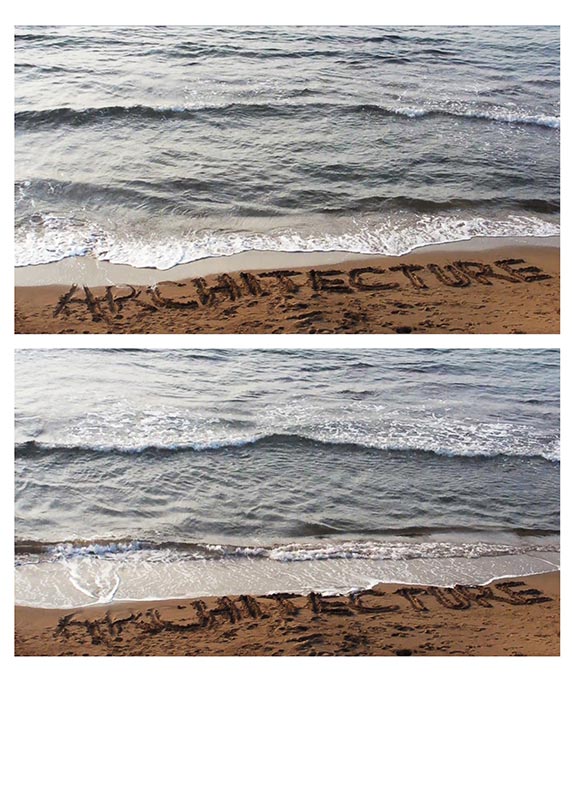
Gianni Pettena, Architecture + Nature, 2011, courtesy of the artist and Salle Principale, Paris © Studio Gianni Pettena
GD: There are a few things that make a huge difference between you and the other members of Radical Architecture. The first one is that you were not a group, just an individuality, albeit with a total absence of style in your practice. You easily recognize the style of Superstudio or Archizoom. Your work in much less recognizable, it eludes the question of signature and authorship.
GP: Right. My works were more tuned up with the research that was going on in the field of visual arts. At that time, I did not look for a signature. Better, I was avoiding to have a style. In doing my work, I was choosing different languages (movies, installations, etc.) while always talking about architecture. Proposing a kind of architecture that was not designed or meant to be built. It was produced physically in the urban context to integrate the vision of my generation in a town built with the vision of the past. There, I was claiming for a space for my contemporary language.
GD: To that purpose, you chose to propose experiences rather than objects, reversible gestures that leave no traces.
GP: I wanted to give shape not only to my point of view, but to give rise to a debate. I was interested by the reactions to or against my work. My very first project, in 1968, a kind a Renaissance building that I adapted for a contemporary exhibition with black and silver stripes, created the reaction of persons that thought that I had destroyed the message of the building. The city administration made a public meeting in the main square, in front of the building, to defend me.
GD: Archizoom, Superstudio or even Archigram have a way of criticizing modernism by exaggerating the consequences of capitalism, in a pop fashion. In comparison, you are much less frontally against things and more aside. Very early, you physically moved to abandoned places, the countryside or the desert, pointing out other ways of living more than criticizing western culture from the inside. There is something in your position that is, I would say, less ironical and more idealist.
GP: Globally my generation was reacting against the philosophy of violence, trying to understand instead those who were different from us. I never thought I was a messenger of truth. I was learning. In the US, we were watching at the native Americans, studying the minorities : different types of communities. We were trying to understand how they were living, what was their vision, etc. My position was being curious at different contexts, physical and sociological. In fact, I was not pop at all. I was, if you want, more of a conceptual artist, one that was trying to speak through a visual language about a philosophy of human relationship.
GD: I see, but the canons of conceptual art missed the body and the emotional part, and that is also what you were exploring in your work. You are more romantic and physical.
GP: We wanted to speak about a reality that was at the same time rational, theorical, and emotional.
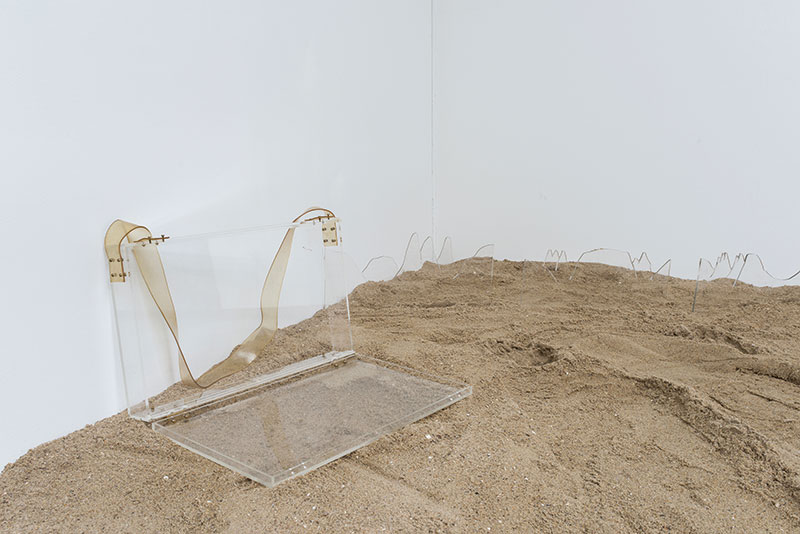
Gianni Pettena, Landscape of memory (detail), 1987, installation, La Verrière, Bruxelles © Isabelle Arthuis / Fondation d’entreprise Hermès
GD: What were your relationships with the organized social and political movements of that time? I think of communist party, operaists, anti-psychiatry, that were very important in Italy.
GP: The communist party was quite strong, but its views were absolutely outdated. In theory, this party should have supported us, but was actually against us. Because we were refusing any sorts of limitations. Myself, I became a member, in 1966, and only for one year and a half, of a party called Partito Socialista di Unita Proletaria, which was much more leftist than the communist party. In fact, the very first time I went to the United States, in order to get a visa, you had to sign a form in which you had to answer this question: “Have you ever been a member of the communist party?”. And I did not answer positively, because in fact I was much more at its left. I knew antipsychiatry and was naturally in favour of it. Besides, I continued my political activities by being a teacher in the University of Florence.
GD: It seems that you were more anarchist?
GP: Yes, in fact. My position was definitely individualist.
GD: Sottsass tells in an interview that you had the plan of throwing a bag liquid red paint to the American Vice-President.
GP: It was in Florence, while the Vietnam War was still going on. I was in the same hotel as Sottsass and asked him if I could go to his room to throw this bag to the Vice-President. It was absolutely an independent gesture. I was only giving shape to my ideas.
GD: It was very dangerous; you could have gone to jail.
GP: Absolutely, but as a good anarchist, I had my strategies.
GD: Which were?
GP: Well, to escape!
GD: It is interesting, because I always thought that your practice is a strange mix of art, theory, activism and pranks. If we take one of your well-known project, Ice House II (1971), a real house transformed in a huge ice cube, we can sense this idea. It is political and poetical, but first of all, it must have been a strange vision for the passer-bys, almost like a practical joke. What were your intentions?
GP: There was a coincidence of elements : the anonymity of the law income housing, the context and the weather, because Minneapolis has very freezing nights in winter. So, it begun with a statement: when architecture is built for profit, it is always built in an anonymous manner, and neglected. I was critical from the leftist point of view about these conditions, for the people who were supposed to live there. And then, as an answer, with some of my students, we built a wooden box around a house, that we filled everyday with about 50 cm of water, so it could freeze during the night. Once we had finish to cover all the building, we dismantled the wooden box, and the Ice house appeared. It could also be a suggestion of how to construct new buildings, more respectful of nature.
GD: Was there a reference to a more basic and vernacular architecture technique, like the igloo.
GP: Yes sure. The condition of using natural materials was a sort of a hymn, a sort of song I was trying to write, about an architecture handmade by the inhabitants, without the participation of any architect.
GD: Is it the same intentions when you do the Clay House (1972), a house totally covered with clay: a reference to the original soil houses and the traditional architecture techniques?
GP: The big difference here is that while the Ice houses were empty, the clay house had inhabitants. I asked the family living there if they agreed to cover their house with clay. So, they lived for a while in this totally covered house: the windows, the walls, the furnitures outside… It was an act of denial of a house built for a small bourgeois white family, living in a white section of the town. Not by chance, the clay was exactly the color of the excrements. The police came, because some neighbors told them that long-haired men were vandalizing the house in front of theirs. A little boy stopped, while we were doing it, and asked me: “are you building something, or are you destroying something?” I think it was the best comment I ever had on this project.
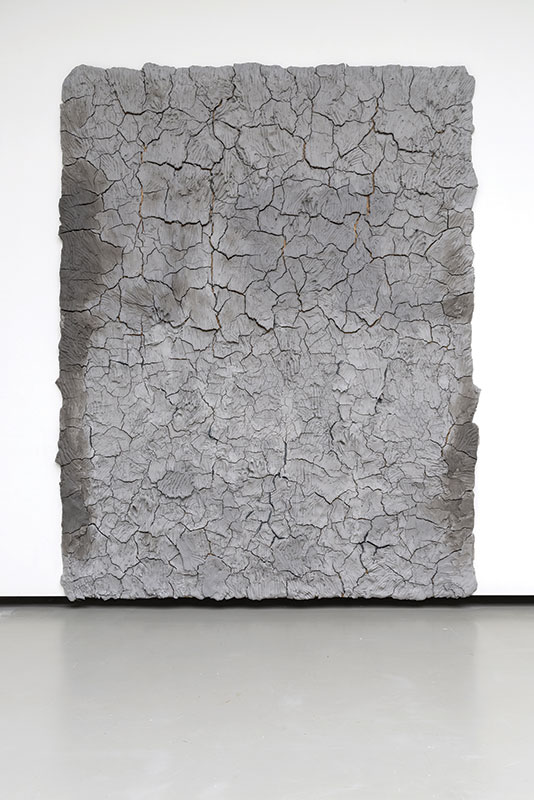
Gianni Pettena, Human Wall, 2012, installation, Federico Luger (FL Gallery), Milan (Italy), courtesy of the artist and Salle Principale, Paris © Antonio Maniscalco
GD: The Ice Houses will melt and the Clay House eventually dries, alterates, welcomes insects and plants. They are living sculptures that change forms. They are out of your control. This is also a denial of the architect as a master.
GP: Absolutely. The negation of a visual, conceptual and political control, that as an anarchist, I disagreed with and I wanted to comment.
GD: To use the semantic of physics, your architecture is conductor, not insulator. The exterior conditions, the seasons, the elements, the temperatures, are intertwining with the life inside the building, which completely denies the modernist ideal of separating from nature, controlling it, even destroying it if needed. I do not remember where, but I read once an interesting statement about modernity as an ancestral war conducted by human beings against nature, considering garden shed as arsenals full of weapons.
GP: I agree. The simple fact that you are building a wall that protects you from nature is the signal that you are not anymore a nomadic member of nature, as any other animal, changing places with the changes of season. You stay there, and you defend your position from nature. It is very different from finding the caverns or using a tipee tent, a foldable nucleus. Nature is not a counterpart anymore, it becomes an alterity, which is not connected to humanity and its behaviour anymore. From that step of sedentarity, we are transforming nature for our personal profit.
GD: In another important project of yours, the Tumbleweeds Catcher (1972), architecture becomes a monument celebrating the humble wastes of nature.
GP: Absolutely, it is a monument celebrating freedom. These tumbleweeds have a dull and stupid life because they are in the desert, and they are waiting for the summer to die. After the death of the bushes, the weeds are starting to tumble, to be carried by the wind. They have a stupid life when they are alive, and a beautiful one, totally free, when they are dead. As soon as humanity made structures, like fences on the highway, the tumbleweeds have been stopped and have been killed a second time. As soon as you conquer some freedom, there is an institution that tries to stop your individual rebellion. You have to obey to the rule of a community. I built this tower in a vacant lot of Salt Lake City to give the tumbleweeds the possibility to bypass the town, and to continue their run along the desert.
GD: About Non-Conscious Architecture (1972-1973) is another seminal project of yours: a series of photographs of the landscape and vernacular buildings, observing different cultural and natural situations in an architectural perspective. It was an original way of practicing architecture without building anything but framing existing situations.
GP: As a European, I was frustrated to live in a continent in which the trace of the previous civilizations are superimposing, centuries after centuries. As a young architect, I was looking for a place in which this presence was absent, and where I could feel like a painter in front of a white sheet of paper. I was told that the South-West of the United States’ desert should be interesting for me. Finally, I discovered that even in these beautiful places, there was a presence of humans, especially within the large reservations of the Navajos. For them, the Monument Valley is “the valley of the temples”. This made me realize that we think that architecture is something that is done by human beings, something that responds to different cultural functions or messages while the nomadic people recognize their own architecture in nature. That is how begun the series of photos.
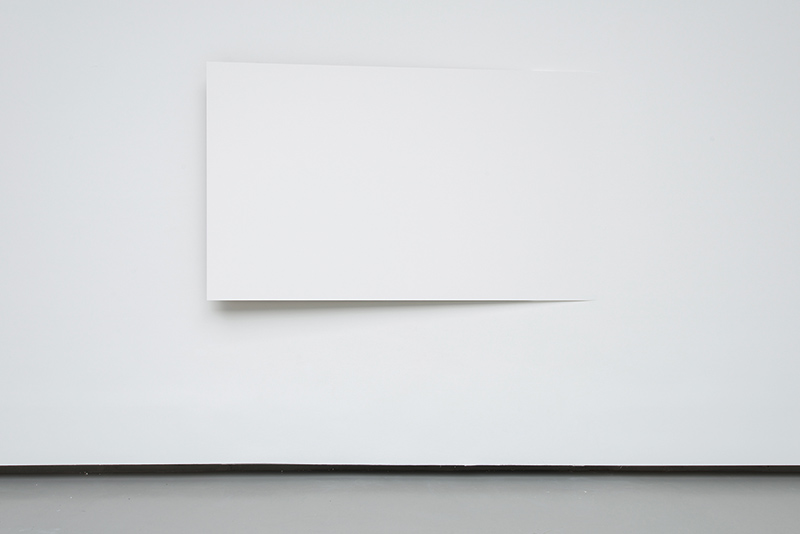
Gianni Pettena, Breathing Architecture, 2012–2013, courtesy of the artist and Salle Principale, Paris © Antonio Maniscalco
GD: You always make gesture that are reversible, making observations rather than productions, experiences rather than objects. This idea of fighting against overproduction and materiality in art is something that we could consider as a real ecology of work.
GP: Yes, in any kind of my art about architecture and environment, there is always this idea of recycling what already exists. The use of natural materials, but also the re-use of materials already produced, that can be recycled, and that can be dismantled after the use. Without producing any kind of pollution.
GD: Another radical and reversible gesture you did is Paper (Midwestern Ocean), (1971), when you filled a gallery with strips of white paper to be cut with scissors by visitors. As an immersive installation, it inverts our perception of architecture, erasing it and facilitating its reappropriation by users, independent of any external, predetermined concept. The piece is a critical examination of “architectural authority”, but also a powerful, sensitive experience.
GP: This piece has been made for the first time 50 years ago, when I was a teacher in the Minneapolis College of Art. At the occasion of a public lecture, we filled up the lecture room with paper coming from the leftovers of a Minneapolis’ newspaper printer and taught the people how to use the scissors to cut the strips. It was an encouragement to give shape to different paths and possibilities, making everyone an architect. Dealing everyday with architectural spaces is something we do quite unconsciously. If this process becomes more conscious, we understand that we are also inventing, communicating through a visual language developed in the space, which is the definition of architecture. So, people cut different passages through the sheet of paper, arrived in the center where they made a bigger, common structure into the strips. Being the cut strips collected as seats, I could began the lecture on my work, having demonstrated the purpose I had in mind, and celebrating the fact that they had just build a new space together.
GD: About the idea of fighting against nature, I was wondering if the tremendous flood in Florence, in 1966, has been determining for you? It has been a very traumatic, but also seminal experience for a generation of political activists in Italy, even in Europe. Do you think this vision, might have had a role in the consciousness that you have of the power of nature and of the precarity of architecture?
GP: Yes, the power of nature but also of the total inefficiency of the administrations. I was working for my graduation thesis and I completely stopped. With my girlfriend we moved to the most damaged part of Florence, to help. Every day, we all had to invent strategies and tricks to feed these 700 people that survived and tried to auto-organize. Then my graduation dissertation concerned the problems due to the flood, and proposed ways to avoid another event like that to happen again. Still, very little has been done. With the climate change, it is not impossible that it happens again.
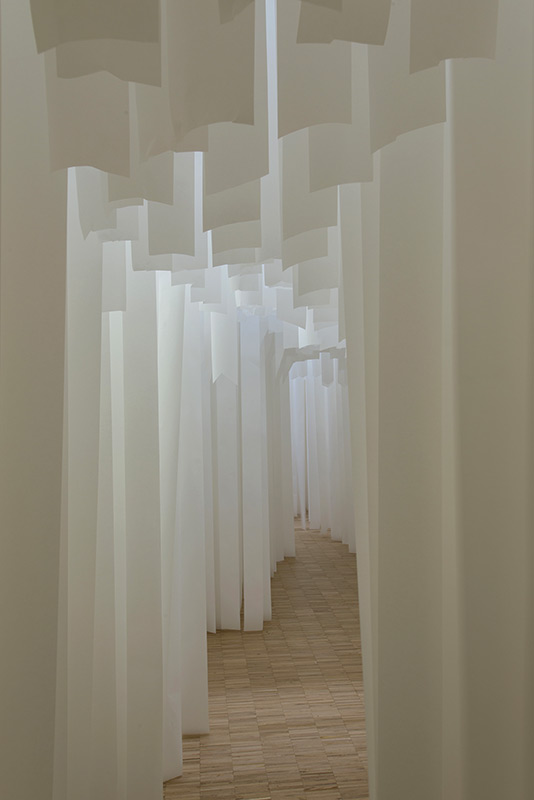
Gianni Pettena, Paper (Midwestern Ocean), performance-installation, 1971-2021, ISELP, Bruxelles © Isabelle Arthuis / Fondation d’entreprise Hermès
GD: We could look retrospectively at your work with those images in mind: Paper (Midwestern Ocean), as a flood of paper totally erasing the architecture, certain vision of catastrophe in the Ice Houses and the Clay House, that looks like mud…
GP: Absolutely. The presence of water, strangely enough, is constant element in my work. Also, there is this lecture with my students in the Thames near London, with my feet in the water . I was very cold, the tide was coming in. At a certain moment, I had to escape because I did not want to be submerged. My way of theorizing my work about architecture was put in danger by the strength of nature. I was teaching that it cannot be fight. Better, that it has to be understood. We have to develop strategies to build a coexistence between mankind and nature.
GD: In the last twenty years, those ecological concern have been growing and becoming a common issue. Everything that was said in the sixties as a political and ideological statement, is not a statement anymore, but simply the plain reality that nobody denies. Do you consider yourself as a pioneer?
GP: The political organization always comes after work. The climate change condition was already dramatic at the beginning of the sixties, but no one was talking about it, except for Richard Buckminster Fuller , that was an engineer, and a kind of a prophet. Or people like the hippies. The new generation has all the right to say that our generations have created the problem. The majority of us remained silent and did not influence the political decisions. And these are the same people that are supposed to make the decisions to stop the pollutions and the climate change. This is why I loved the upset Greta Thunberg speaking very violently at the United Nations. She was very severe, and absolutely right. This is something that makes me mad, the fact of where was I when they were destroying our planet, and that I was not doing enough.
GD: Your work is mainly about fighting against domination, especially the superior figure of the architect: the strong, powerful, educated wealthy male, master of art and science. In response, your position is totally anti-heroic. In mestiere dell’architetto (2002) you are trying to climb a mountain, in a very minoritarian position. I would like to hear you on recent debates on minoritarian revendications, the post-colonial and neo-feminist movement for example, that some liberal or leftist people of your generation sometimes denigrates. When you look at the picture of Radical Architecture, there is no woman.
GP: Yes, almost not any. In architecture in general, except from Zaha Hadid , that has been an incredible strong fighter, Odile Decq, Elizabeth Diller (Diller/Scofidio/Remfro), Kazuyo Sejima, just to remember the ones I love most. I totally agree and sympathize with the new fight against violence, and for the minorities, especially the new feminists. When I was teaching in Minneapolis, I had native and black students and half of the class were women, there were beautiful discussion but, it’s true, not too many initiatives. Unfortunately, every generation has to fight for their reasons, their voice, their opinion. They have the right of fighting their own battle, and they even have the duty to fight. Otherwise, we all renounce to our ethical job.
In the frame of the program “Matters of Concern | Matières à panser”, curated by Guillaume Désanges at La Verrière-Fondation d’entreprise Hermès in Brussels, Pettena did his first solo exhibition in Belgium in the beginning of 2021. Part sensory experience, part documentary retrospective, the exhibition reactivated a large selection of past works, including a large installation, entitled Paper (Midwestern Ocean) at ISELP (Institut Supérieur pour l’Etude du Langage Plastique)
Cover picture: Gianni Pettena © Studio Pettena
